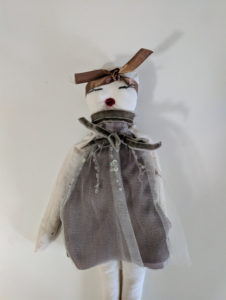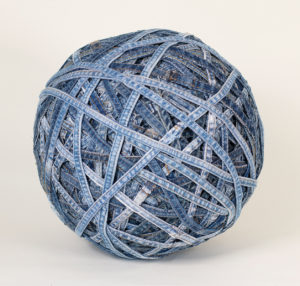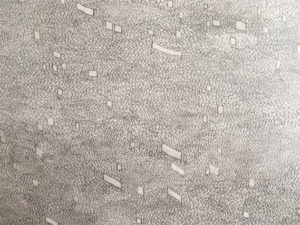March 28 – April 29, 2019
University Place Gallery
124 Mt. Auburn Street, Cambridge MA
Featuring artwork by Kimberly Becker, Michèle Fandel Bonner and Elena Brunner
Click here to download the Press Release
About | The notion of “many” is powerful. When presented with multiple images, the viewer tends to pause and look. Hundreds of something conjures a sense of commitment. Time invested in a concept speaks to dedication.
Each of the three artists featured in this exhibition have their own way of “keeping count”. Each of these women has found the power of “many” to be a launching point for communicating their message.
The hope is to convey these messages and begin, or continue, a more broad conversation about the times we are living in.
about the artists

Kimberly Becker | Using needle and thread, paint and brush and narrative, I create art that tells women’s stories. We live in a world that often diminishes women. Just ask any woman if she has ever been overlooked, held back, disregarded or underestimated. I seek to tell women’s stories in an effort to educate. Using clothing as my vehicle, I sew diaphanous dresses that carry each story and an image of the house the woman lived in when the story occured. The first collection of dresses are the House Dresses, and the second are the Roe House Dresses. The Roe House Dresses focus in on stories that either happened because the storyteller was living during the years since Roe V Wade was made federal law, or stories of women who were not so lucky. Abortion, access to Planned Parenthood and legal birth control are each part of this conversation. The current political climate threatens women’s rights and autonomy again. I feel a responsibility to speak out with my art against what I see as unfair. My latest project, the Resistance Dolls, are my way of keeping daylight on the fact that we have a Supreme Court justice who is an accused rapist. I am making a doll every day until Justice Kavanaugh is impeached and removed from the bench. This is my contribution to women and equality. Women must retain control of their own bodies and decisions. I know I live in a state where my daughter will always have access to safe healthcare, but I am fighting for the young women who are not so fortunate, and don’t even know that their independence is at risk.

Michèle Fandel Bonner | My work highlights the beauty, meaning, and potential of found and accumulated objects. My choice of media interrupts the typical path of overflow that would otherwise often ends in trash heaps. I find inspiration in the physical characteristics of the objects that I collect, but also in their past uses and the lives they once touched.
At times, the objects act as a link to a backstory, a feeling or an event, personal or public. “96 a Day” is an ongoing project begun after the Sandyhook massacre. While “Family Secrets” addresses the sometimes fraught facade families present to the outside world, “Since” presents the daily relief of a cancer cure.
When an object captures my attention, I begin to collect it, amassing hundreds of specific items. After sorting and preparing, I begin to assemble the many parts together with stitches, adhesive, hardware or pins, working intuitively so that the materials lead me. I don’t always immediately know what form the resulting work will take, but once I do, in a sudden flash of awareness that takes place deep into the making process, I imagine it completely realized. From there, it’s like putting a puzzle together. My work often make familiar, discarded objects seem new again, lightened by distance from their old associations and transformed by my durational practice.

Elena Brunner | In the aftermath of trauma, what gets left behind? I am interested in the intersection of power, cultural memory, cultural forgetting, and how they relate to whiteness and masculinity in America.
How do you remember something your culture is trying to forget? I am trying to give shape to the memory of abuse. We white people share histories we don’t want to name, in which we perpetuated and are still perpetuating violence against non-white bodies. And yet we go to great lengths to resist critical examinations of White History in this country. We know that protecting ourselves from the shame and guilt of these abuses is easier than seeing ourselves as monstrous.
What happens when we move through the world protected with invisible shields? How does having an exoskeleton of privilege change how we perceive the the world? What must we look like from the outside? Does it matter whether the person behind the mask recognizes the power they have?
The work started with the idea of exploring the ‘police presence’ but the drawings have turned into specters or ghosts. I think about legacies of white supremacy and what kind of marks it leaves, and as the oppressors, where do these marks hide in us?
dates
Reception | Thursday, April 4, 6-8pm at University Place
Artist Talk | Wednesday, April 17, 6:30-8pm at University Place
Program | Monday, April 8, 12-1:30pm at University Place
- Join us for a session of slow stitching, knitting, mending or bring your own UFO (unfinished object) to work on. We will be talking about the issues that our show stirs up and sharing techniques in the different projects we have on hand.It will be a casual mid day gathering. Please join us if you can.Click here to RSVP to the program!